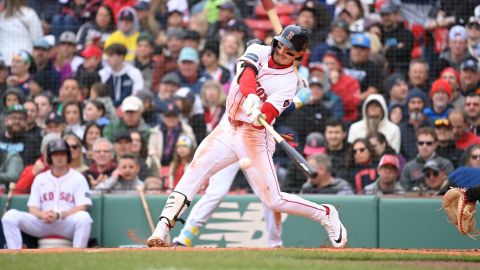 For years, if you asked any left-handed batter in the American League who they least enjoyed facing, the answer was almost always Jon Lester. That, of course, was due to the action on the 29-year-old’s infamous cut fastball, which Lester liked to start at a left-handed batter’s hip and move to the inside corner.
For years, if you asked any left-handed batter in the American League who they least enjoyed facing, the answer was almost always Jon Lester. That, of course, was due to the action on the 29-year-old’s infamous cut fastball, which Lester liked to start at a left-handed batter’s hip and move to the inside corner.
Going back to Lester’s final four starts of the 2011 season, however, Lester just hasn’t been very good — nowhere near the consistency he achieved before that. But it was that long-term consistency (65-32, 3.33 ERA from 2008 through 2011) that made most people believe that 2012 was the fluke, and with a little work Lester could get back to his old form in 2013.
Early in the year, Lester obliged, going 6-0 with a 2.72 ERA over his first nine starts, just once allowing more than three runs. Since that point, however, Lester has gone 0-3 with a 6.90 ERA in five starts.
So, the obvious question becomes why is Lester so bad now, when he was so good to start the year? Unfortunately, the answer isn’t very straightforward.
On Wednesday, ESPN’s Buster Olney spoke with WEEI to talk Red Sox, with Lester foremost among the topics. According to Olney, internally the Red Sox are concerned with Lester’s mechanics, which was much the same problem which plagued the southpaw last year.
“The Red Sox really think he is fouled up mechanically,” Olney said. “It was interesting when we had a conversation with John Farrell before we did the Sunday night game about 10 days ago. He was fairly circumspect when he was talking about [Clay] Buchholz and he was talking about Lester and he made sort of these references to Lester’s mechanics, and his concern is that he tries to draw his arm back a little bit farther and get a little bit extra and that is when he begins to lose it.
“I know that going forward what their plan is with him is to get him back to doing what he was doing in spring training in the early part of this year in standing tall on the rubber and throwing downhill. But they have felt all along that he is someone who tends to drift in and out of his mechanics, and I think that is what is going on right now with him.”
So, is it that simple?
The answer is that mechanics are probably the best explanation for Lester’s struggles at this point. Likewise, it’s not easy to look at Lester’s numbers and pinpoint one trend or outlying statistic that would be affecting his effectiveness either way.
The only corollary among Lester’s peripherals seems to be his ground ball rate, but even that isn’t a very strong trend. Over Lester’s first three starts of the season, the percentage of in-play balls on the ground was 45 percent or below. Of course, Lester’s never really been a ground-ball pitcher, either, as he’s only had one season (2010) where he had significantly more fly balls than ground balls (putting up a 1.17 ratio that year).
Basically, Lester has tended to do better in games he has induced more ground balls, but that isn’t necessarily a foolproof predictor.
The other downward trend for Lester has been his walk rate. Through those first nine starts, Lester had only two outings in which he walked three or more batters — in fact, in five of those games he walked one or none. In the five starts since, however, he’s walked three or more four times, including Tuesday’s seven-walk effort.
But is Lester just losing control, or is he nibbling too much to compensate for something else that’s going on? This is where we return to the discussion of Lester’s mechanics.
Though Olney didn’t elaborate too much on what, specifically, is wrong with Lester’s mechanics, here’s betting that it has a lot to do with his arm slot. In short, the reason that Lester was so effective for so long against left-handed batters was because of his dramatically over-the-top motion. Lester utilized the kind of ultra-textbook mechanics that every Little League coach should be teaching their players.
However, last season Lester’s arm slot was clearly lower than it ever was before. What that did is flattened his pitches, and took away the natural horizontal break on his cutter, specifically, which mitigated his overall effectiveness.
Looking at the image above, the picture at the left is of Lester in 2006, while the picture on the right is this year. At first it’s subtle, but once you see it you can’t un-see it — Lester’s arm slot is undoubtedly lower than it was earlier in his career. Lester actually looks to have better balance in 2013 over his center of gravity, but it’s that lean to his right in years past that allowed him to get on top of the ball so well.
So, it seems that Lester’s lack of control may not be due to factors beyond his control. To the contrary, it’s a reasonable inference that he’s trying to live on the edges of the strike zone even more often, to compensate for stuff that isn’t quite what he’d like to have.
All in all, Lester should still have the physical gifts to be a very good pitcher. However, far more talented pitchers than Lester have succumbed to an inability to repeat their delivery, which is what is so concerning for him. The fact that he was so good for so long begs the question if there isn’t an injury behind his dropped arm slot, but that would be pure speculation.
Either way, for the Red Sox’ sake, they’d better hope that Lester can find his delivery again. The fate of 2013 may depend on it.




